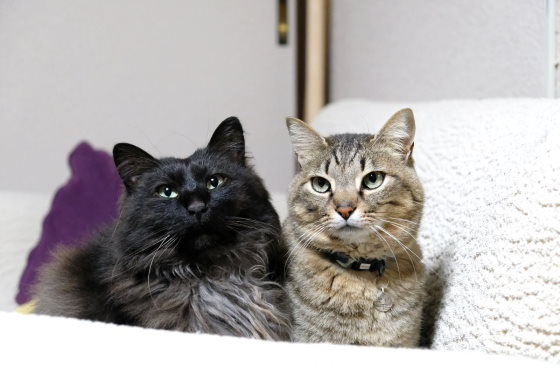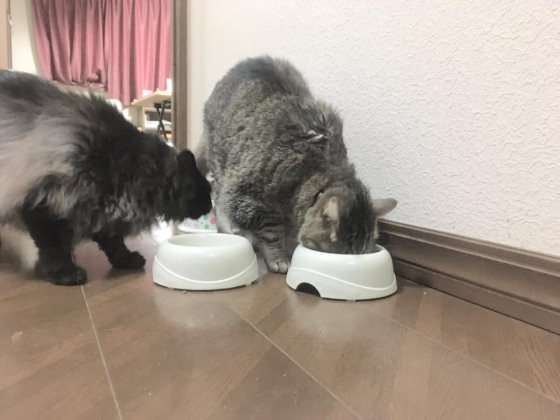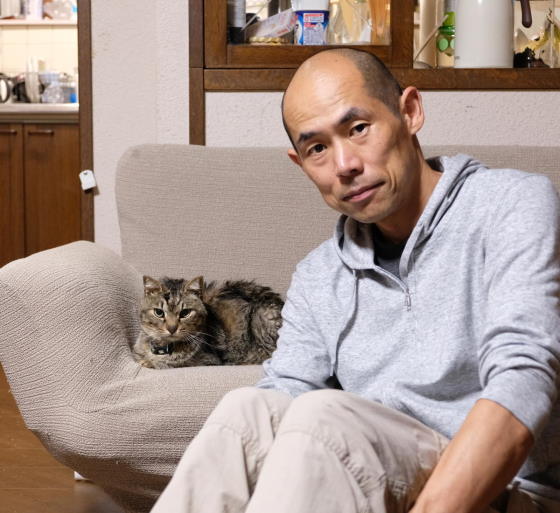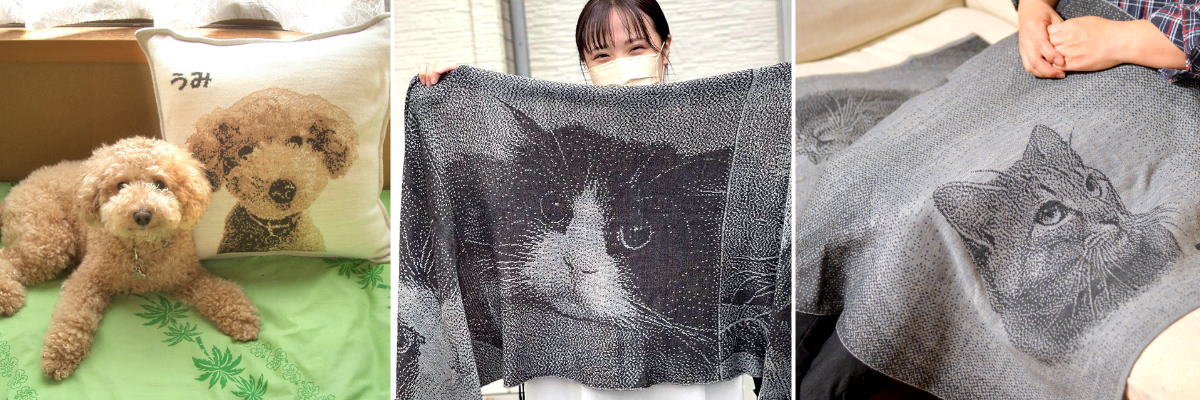
This is our cat.
The black cat on the left is named Sora.
The brown tabby on the right is Maro
Maro got sick.
Cat’s extreme weight loss
Maro (brown tabby cat) is a cat that eats a lot. He gains weight easily (6.2kg).
Sora (black cat) is a cat that doesn’t eat much. But he gains weight (6kg).
I was worried because When I feed Sora and Maro, Maro would eat as much as two cats.
April 2020
Maro was gaining weight, so I changed him to food that he doesn’t like very much.
He’s gradually reduced the amount he eats, so his diet seems to be a success.
May 2020: Extreme weight loss
Hmm, Maro, have you lost weight?
When I brush him, he looks really thin.
Maybe it’s because he’s shed his winter fur?
But he also looks haggard when he’s walking.
When I weighed him, he was about 4.2kg. He’s really thin.
I realized around May 8th that something was wrong.
Even when I put his food back in his delicious food, he wouldn’t eat it.
What’s that?
I watched him for a while, but something was still wrong.
I brought him to the vet on May 14th.
On May 14th, thinking that something was wrong, I brought him to the vet.
His weight had further decreased to 3.8kg.
It seems that he was dehydrated (I didn’t know this).
I immediately had a blood test done.
Abnormalities were found in his liver values.
I had him put on an IV drip temporarily, and we decided to examine him in more detail the next day.
Perhaps the IV drip was effective, but the cat seemed to be feeling a little better that night.
May 15th. X-ray and ultrasound
After consulting with the doctor, I had an X-ray and ultrasound done.
The X-ray and ultrasound revealed a shadow of unknown origin.
However, the cause of the shadow remains unknown.
It looks like a tube, but it’s unclear what organ it is.
To find out what the shadow is, one option is to have the cat drink barium or perform an incision (surgery).
However, this would be very stressful for the cat, and unlike humans, organs cannot be removed.
In other words, they can diagnose the disease, but it may not be possible to treat it.
It also places a burden (mental, financial, etc.) on the owner.
In the doctor’s experience, he had made an incision and been able to identify the cause of the illness, but in the end was unable to provide any treatment.
For these reasons, he said that incision is not recommended.
In particular, he said that if it was cancer, it would not be treatable.
We discussed what kind of treatment we should proceed with.
We decided to try less stressful medications for the time being.
After the infusion on the 14th, Maro seemed to be feeling a little better, so we tried infusion at home.
I got an at-home IV kit for two days.
We’ll be trying infusions at home on the 16th and 17th.
When we got home after the test, for some reason we ate two meals worth of food greedily.

Huh? Are you feeling better?
A second opinion
We adopted Maro from an animal shelter.
The facility has the equipment to perform more detailed examinations.
It’s a little far from our home, but when we reported Maro’s condition to the facility, they said we could have a CT scan.
I think a CT scan is one that takes cross-sectional pictures of the inside of the body, just like with people.
This will provide more detailed information.
However, even if I found out the cause, I wouldn’t be able to treat it (by removing the stem cells, etc.).
In addition, the treatment costs would be very high.
When I think about it like that, I’m thinking that it’s fine to continue the way I am now.
16th and 17th, cat given intravenous drips
I never dreamed I’d be giving an IV to a cat , but Maro is a good boy so the IV went smoothly.
The medicine is injected into the IV solution, and a needle is inserted into the neck to allow the liquid to flow in.
Unlike human IVs (which go directly into veins), this fluid is administered subcutaneously (under the skin).
The IV solution drips all over the neck, shoulders, and front legs.
It takes about 24 hours for the solution to be absorbed into the body.
May 18th: Discuss what to do next
On May 18th, we went to our regular doctor.
Maro weighs 3.95 kg.
He’s gained 1.5 kg since Friday.
Maybe the IV is working?
They say he seems to be in better condition than on the 14th.
He looks the same to me.
I asked how to tell if someone is dehydrated.
Apparently the first thing to do is pinch the skin.
If a cat is dehydrated the skin won’t go back to normal.
In Maro’s case, it went back to normal slowly.
As an experiment, I pinched Sora’s (the black cat’s) skin and let go, and it went back to normal in an instant.
I see, the difference is very clear.
Maro seems a bit dehydrated.
1週間分の薬と2回の点滴を受けました。
1週間様子を見て、どうするか決めます。
May 19th night: weight 3.8kg
May 20th night: weight 4kg, ate food.
May 20th evening: weight 3.5kg
He’s a little thin, and just lifting him up makes him feel “light”.
He didn’t seem to be eating, and he looked dehydrated, so I gave him an IV drip.
After the IV drip, he did seem to be a little better.
Extrahepatic bile duct obstruction in cats
On May 22nd, I was browsing Instagram for posts about cat illnesses.
There I discovered some cats with symptoms very similar to Maro’s.
One of the tags I came across was for a disease called feline extrahepatic bile duct obstruction.
What follows is some information I found online through my own personal search, as well as my amateur opinion.
I searched for the keywords “extrahepatic bile duct obstruction in cats.”
When I did an image search, I found a photo that was very similar to the X-ray I had seen for Maro.
It was an article written by a veterinarian about surgery for a disease called extrahepatic bile duct obstruction in cats.
The results of the X-ray and ultrasound were very similar to Maro’s.
Treating this disease requires surgery to remove the liver, which is apparently very difficult.
What’s more, because the liver is swollen due to the disease, it is prone to bleeding.
The cat was also put under general anesthesia.
It was not that the surgery was a failure, but rather that because it is a surgery that involves bleeding, death during the operation is possible.
The site said that the surgery was a success, but post-operative treatment is apparently difficult.
Cost for liver removal surgery in cats
After that, I looked into the cost of surgery for my cat.
It was painful to have to weigh life against money, but I had to face reality.
The cost varies depending on the hospital, but it’s generally between 200,000 and 400,000 yen.
But this is only for the surgery.
My family doctor also takes the burden on pet owners into consideration.
And he said that in my case, surgery is not recommended.
It would be a significant burden on both pet and owner, and while surgery might extend the pet’s life a little, it might also mean that the pet will suffer longer. He thinks that it would be better to cherish the time we can spend together and let the pet spend its time happily at home.
I think that would make Maro & me happier too.
Balancing pet life and medical costs
I was faced with the reality of the medical expenses and money for my cat.
Even if I wanted to talk to someone, the moment I chose who to talk to, I already knew what I wanted.
There were people who recommended surgery.
It was the veterinarian at the facility where Maro was staying.
The hospital has excellent facilities and skilled veterinarians, but surgery costs hundreds of thousands of yen.
I told the person about Maro’s condition, and they said they could treat him there, so to contact me if I wanted to.
I haven’t been able to find the courage to contact them since then.
It’s because of the high medical costs.
There are people who don’t recommend surgery.
These include Maro’s regular veterinarian and my friends (who have seen many pets die).
I find myself wanting to consult with them.
Their answer is likely to be to not push the cat any further and to encourage it to take its natural course.
Each person’s way of thinking will vary greatly.
But we all share the same love for pets, and we all feel the same pain.
I hope we can all understand that there are many different ways of thinking.
Staying overnight at the hospital
When I go away for work or travel, I leave my cat at the same hospital.
Maro is used to it, and is even more attached to the doctors and nurses than I am.
I had Maro examined at the hospital for two nights, on June 27th and 28th.
I think it was a very happy time for Maro.
He was given an IV drip and examined (to observe his condition).
Apparently he didn’t eat any food at all. Just like at home.
Vet told me he didn’t have much longer to live.
But it seems like Maro relied on everyone a lot,
and vet said Maro was “a really cute, friendly and patient boy.”
The day before death

This is Maro and me three days after we came home from the hospital.
Every day Maro tries to climb onto my lap.
He can’t even climb up on this sofa, so I have to help him.
On this day, Maro seemed a little more energetic, so we took a photo together.
Looking back, it was as if he was saying goodbye…
The next day, Maro passed away and went to heaven.
Farewell
On Friday morning, Maro tried to come and sit on my lap as usual.
But something was clearly wrong.
He couldn’t walk.
He was taking a rest at the bottom of the shelf where he always is.
He got up a little,
and I thought,
“Hmm?”
It seemed something was wrong.
I quickly prepared a bed for him and let him sleep.
It’s still too painful for me to write about what happened, but
at the end,
I stroked his head and said,
“You did a great job,”
and Maro replied in a small voice,
“Yeah.”
Maro’s breathing was shallow.
I headed off to work,
but I got worried so I returned home soon after,
and Maro had already passed away.
To find out what happened after that, please see How to cope with the loss of a pet.
